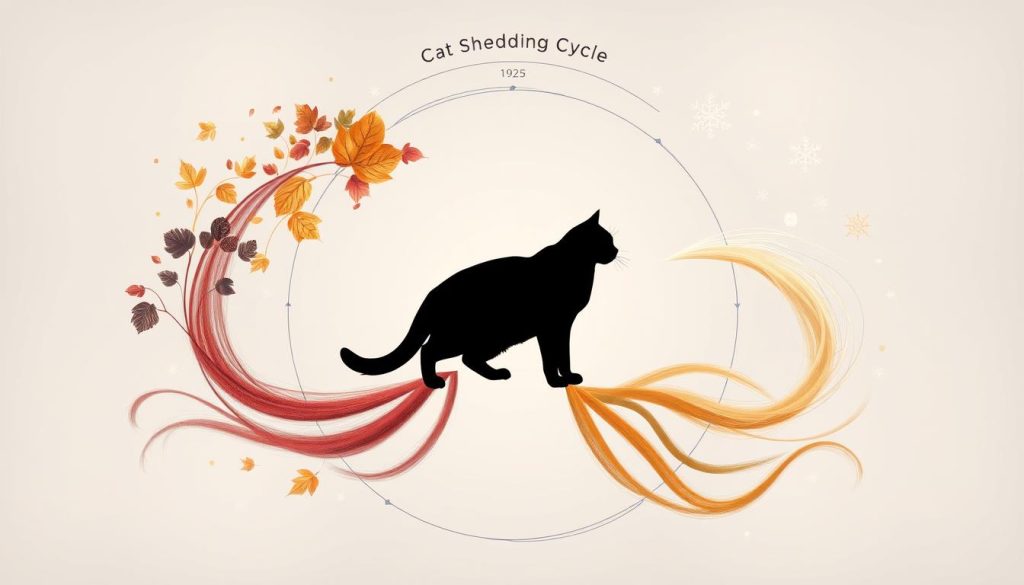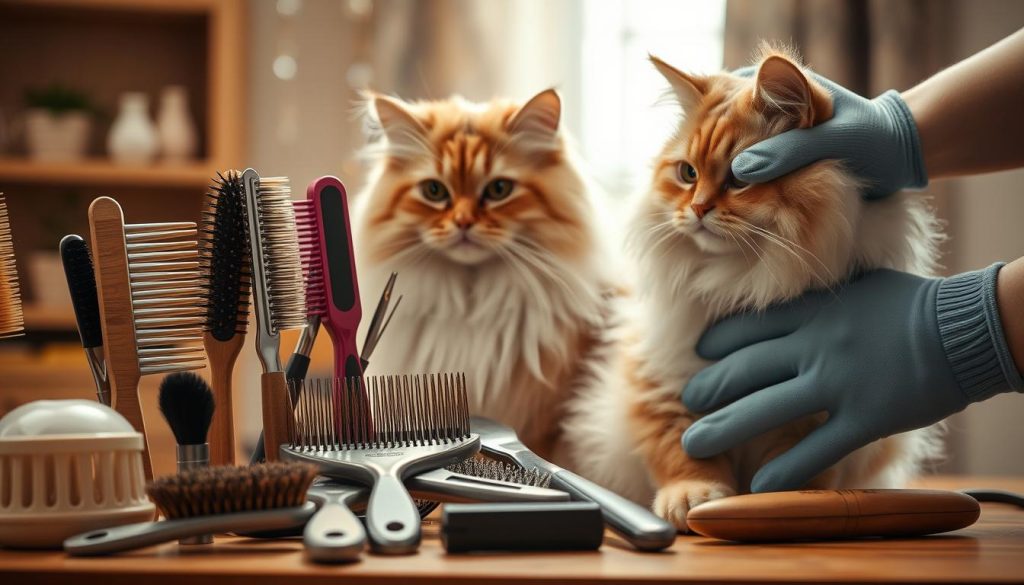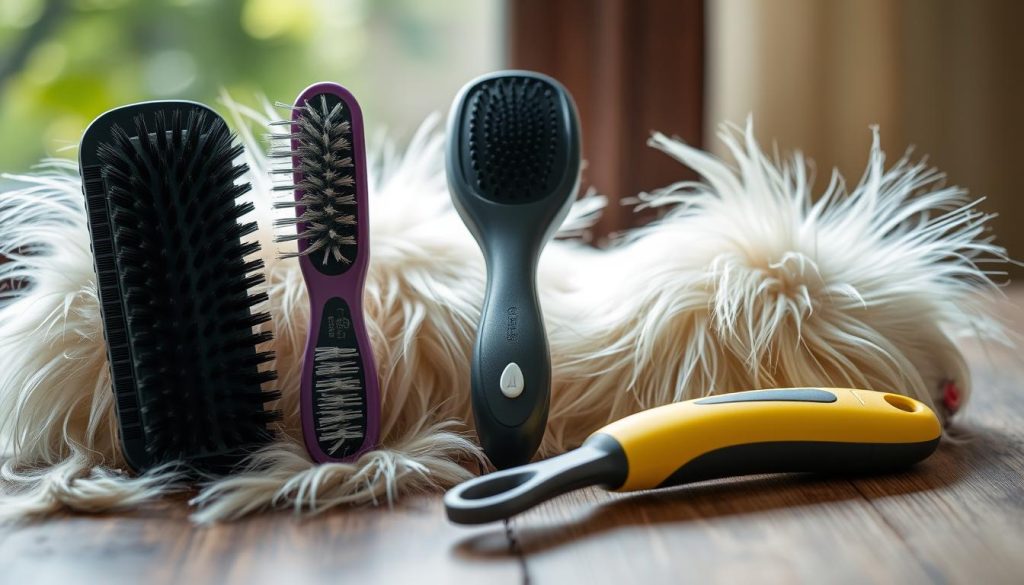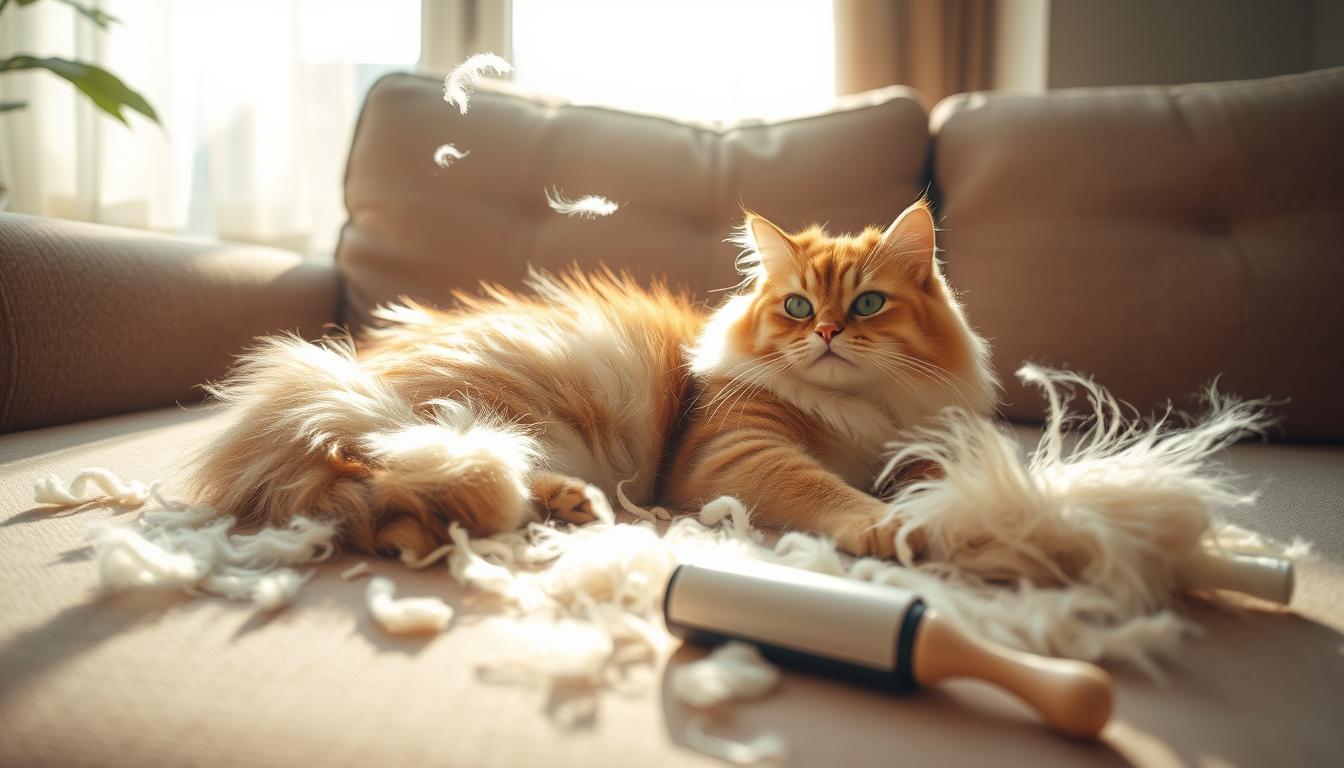As a pet owner, I know how frustrating cat shedding can be. Finding hairs on furniture or cleaning fur-covered surfaces is a constant task. But, with the right strategies, you can manage your cat’s shedding. This guide will share tips to keep your home fur-free and your cat’s coat healthy.
Understanding cat shedding and grooming routines is key. I’ll cover diet, supplements, and creating a stress-free environment for your cat. By the end, you’ll know how to control your cat’s shedding and keep your home clean.
Understanding Cat Shedding: A Natural Process
As a proud cat owner, you’ve likely seen your cat’s seasonal shedding. It might seem like a never-ending fight against fur. But, shedding is a natural part of a cat’s life. Knowing why and how much they shed can help you manage it better.
Why Do Cats Shed?
Cats shed to keep their coat healthy and warm. This is part of their cat shedding cycle. The cycle changes with the seasons and the weather. As the weather changes, cats shed their old coats for a new, lighter one.
Factors Affecting Shedding Levels
The cat shedding cycle is natural, but the reasons and how much they shed can vary. Several factors play a role:
- Seasonal Shedding: Cats shed more in spring and fall as they switch coats.
- Breed Differences: Some breeds, like Persians and Norwegian Forest Cats, shed more because of their thick fur.
- Environmental Factors: Temperature, humidity, and stress can also affect how much a cat sheds. Changes in their environment can make them shed more.
Understanding the cat shedding cycle and how environmental factors affect it can help you prepare for and manage shedding at home.

Grooming: The Key to Controlling Cat Shedding
As a proud cat owner, I know how frustrating excessive shedding can be. Regular grooming is the solution. Brushing, bathing, and using deshedding tools can cut down on hair in your home.
Brushing is a top way to manage shedding. It removes loose and dead hair before it spreads. Choose a brush made for cats to catch shed fur effectively.
- Brush your cat 2-3 times a week to control shedding.
- Focus on areas like the belly, back, and legs where they shed most.
- Use gentle, long strokes to avoid hurting your cat’s skin.
Bathing your cat regularly can also help with shedding. Even if they don’t like it, a gentle bath can remove hair and keep their coat healthy.
For more shedding control, try deshedding tools like undercoat rakes or brushes. They’re made to get rid of the thick undercoat that causes shedding.

Consistent, professional grooming is key to a fur-free home. By adding these techniques to your cat’s routine, you’ll have a cleaner, happier space. Plus, your cat will get the care they need.
The Power of Brushing: Reducing Loose Hair
Brushing your cat’s coat regularly can change the game in controlling shedding. It removes loose hair before it spreads all over your home. This way, you can cut down on fur buildup. We’ll look at how to pick the right brush and the best brushing methods to reduce fur.
Choosing the Right Brush
The right brush is key to managing your cat’s shedding. Different coats need different brushes. Here are some tips for picking the best brushes for cats:
- For short-haired cats, a rubber grooming glove or a slicker brush can work wonders in removing loose fur.
- If your cat has a medium-length or long coat, an undercoat rake or a deshedding tool will be more effective in catching those pesky tufts of fur.
- Avoid using bristle brushes, as they may not be gentle enough on your cat’s sensitive skin.
Proper Brushing Techniques
Brushing your cat regularly is crucial, but the way you do it matters. Follow these best brushing tips to effectively reduce loose hair and minimize fur removal:
- Start with short, gentle strokes, gradually working your way through the coat.
- Focus on areas where shedding is most prominent, such as the belly, legs, and back.
- Be mindful of your cat’s comfort level and take breaks if they seem stressed or uncomfortable.
- Brush in the direction of the fur growth to avoid causing discomfort or irritation.
- Finish by using a damp cloth or grooming wipe to pick up any remaining loose hairs.
By choosing the right brush and using proper techniques, you can reduce loose hair at home. This keeps your cat’s coat looking great. Regular and gentle grooming is essential for a low-shedding environment for both you and your cat.

Cat shedding control: Diet and Supplements
Keeping your cat’s diet healthy and adding the right supplements can really help with shedding. Omega-3 fatty acids are especially important. They help keep your cat’s coat healthy and reduce fur loss.
Omega-3 Fatty Acids and Shedding
Omega-3 fatty acids are great for cats. They improve skin and coat health. These nutrients make your cat’s fur smoother, shinier, and healthier.
Adding omega-3-rich foods or supplements to your cat’s diet can cut down on shedding. It also boosts their coat health.
Other supplements like vitamins and minerals can also help with shedding. Look for ones that support coat health and reduce fur loss.
Talk to your vet to find the best diet and supplements for your cat. They can help you make changes to control shedding and keep your cat’s coat looking great.
Creating a Low-Stress Environment for Your Cat
As a devoted cat owner, I know how vital it is to keep our feline friends stress-free. Stress can make cats shed more, so we must act to create a calm space. This space should help your cat feel better.
Reducing stress in cats starts with environmental enrichment. This means giving your cat fun activities and things to do. Things like scratching posts, climbing structures, and toys can help. They keep your cat happy and busy.
Managing your cat’s anxiety is also key to less shedding. Changes, new places, or strangers can stress them out. This stress makes them groom more, leading to more hair loss. To help, use calming scents, stick to a routine, and give them a cozy spot to hide.
By enriching your cat’s environment and managing their anxiety, you can help them shed less. A happy cat has a healthy coat and sheds less. This makes grooming easier for both of you.
Vacuuming Strategies for Pet Owners
Managing cat shedding can be a big challenge for pet owners. Using the right vacuum is key to keeping your home clean and free of fur. We’ll look at the best vacuum choices and share top vacuuming tips for pet hair.
Choosing the Right Vacuum
Not all vacuums are good for pet hair. When picking a vacuum, look for pet-friendly features. Important things to consider include:
- Strong suction power to lift and remove pet hair well
- HEPA filtration to catch small hair and dander
- Pet hair attachments for focused cleaning
- Easy to move around furniture and tight spots
Choosing a top-notch, pet-friendly vacuum can greatly help keep your home clean.
Efficient Vacuuming Techniques
With the right vacuum, it’s time to start cleaning. Here are some top vacuuming tips for pet hair:
- Make vacuuming a regular part of your routine, especially in busy areas.
- Focus on spots where pet hair collects, like furniture and corners.
- Use the right tools to clean tight spots and around furniture.
- Vacuum in the direction of the pile for best hair removal.
- Keep the vacuum’s filters and bags clean for best performance.
By following these vacuuming tips, you can manage cat shedding and keep your home clean.
| Vacuum Feature | Benefit for Pet Owners |
|---|---|
| Strong Suction Power | Effectively lifts and removes stubborn pet hair |
| HEPA Filtration | Captures even the smallest hair and dander particles |
| Pet Hair Attachments | Provides targeted cleaning for hard-to-reach areas |
| Maneuverability | Allows for easy navigation around furniture and tight spaces |
Embracing the Fur: Accepting Shedding as Part of Pet Ownership
As a devoted cat parent, I’ve learned that managing my cat’s shedding is a constant task. While the tips and strategies in this article help reduce hair around my home, it’s key to accept that some shedding is natural. It’s a part of owning a cat.
Cats shed to keep their coat healthy, control their body temperature, and get rid of old or damaged hair. As pet owners, we must do our best to manage this shedding. Yet, we must also accept that some fur is unavoidable when caring for our feline friends.
By adjusting my expectations and embracing the fur, I’ve found joy in owning a cat without being overwhelmed by shedding. That soft, cuddly fur shows the unconditional love and companionship our cats offer. So, I’ll keep grooming my cat, keeping my home clean, and be proud of being a responsible pet parent. And I’ll accept the occasional stray hair as a small price for the joy of sharing my life with a furry friend.

